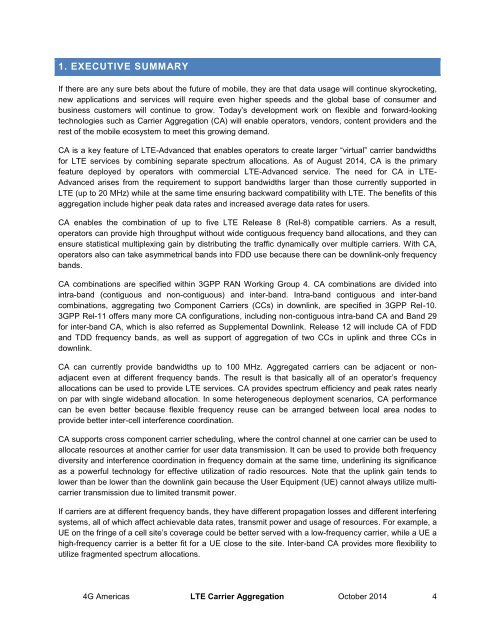4G Americas Carrier Aggregation_FINALv1 0 (2)
4G Americas Carrier Aggregation_FINALv1 0 (2)
4G Americas Carrier Aggregation_FINALv1 0 (2)
Create successful ePaper yourself
Turn your PDF publications into a flip-book with our unique Google optimized e-Paper software.
1. EXECUTIVE SUMMARYIf there are any sure bets about the future of mobile, they are that data usage will continue skyrocketing,new applications and services will require even higher speeds and the global base of consumer andbusiness customers will continue to grow. Today’s development work on flexible and forward-lookingtechnologies such as <strong>Carrier</strong> <strong>Aggregation</strong> (CA) will enable operators, vendors, content providers and therest of the mobile ecosystem to meet this growing demand.CA is a key feature of LTE-Advanced that enables operators to create larger “virtual” carrier bandwidthsfor LTE services by combining separate spectrum allocations. As of August 2014, CA is the primaryfeature deployed by operators with commercial LTE-Advanced service. The need for CA in LTE-Advanced arises from the requirement to support bandwidths larger than those currently supported inLTE (up to 20 MHz) while at the same time ensuring backward compatibility with LTE. The benefits of thisaggregation include higher peak data rates and increased average data rates for users.CA enables the combination of up to five LTE Release 8 (Rel-8) compatible carriers. As a result,operators can provide high throughput without wide contiguous frequency band allocations, and they canensure statistical multiplexing gain by distributing the traffic dynamically over multiple carriers. With CA,operators also can take asymmetrical bands into FDD use because there can be downlink-only frequencybands.CA combinations are specified within 3GPP RAN Working Group 4. CA combinations are divided intointra-band (contiguous and non-contiguous) and inter-band. Intra-band contiguous and inter-bandcombinations, aggregating two Component <strong>Carrier</strong>s (CCs) in downlink, are specified in 3GPP Rel-10.3GPP Rel-11 offers many more CA configurations, including non-contiguous intra-band CA and Band 29for inter-band CA, which is also referred as Supplemental Downlink. Release 12 will include CA of FDDand TDD frequency bands, as well as support of aggregation of two CCs in uplink and three CCs indownlink.CA can currently provide bandwidths up to 100 MHz. Aggregated carriers can be adjacent or nonadjacenteven at different frequency bands. The result is that basically all of an operator’s frequencyallocations can be used to provide LTE services. CA provides spectrum efficiency and peak rates nearlyon par with single wideband allocation. In some heterogeneous deployment scenarios, CA performancecan be even better because flexible frequency reuse can be arranged between local area nodes toprovide better inter-cell interference coordination.CA supports cross component carrier scheduling, where the control channel at one carrier can be used toallocate resources at another carrier for user data transmission. It can be used to provide both frequencydiversity and interference coordination in frequency domain at the same time, underlining its significanceas a powerful technology for effective utilization of radio resources. Note that the uplink gain tends tolower than be lower than the downlink gain because the User Equipment (UE) cannot always utilize multicarriertransmission due to limited transmit power.If carriers are at different frequency bands, they have different propagation losses and different interferingsystems, all of which affect achievable data rates, transmit power and usage of resources. For example, aUE on the fringe of a cell site’s coverage could be better served with a low-frequency carrier, while a UE ahigh-frequency carrier is a better fit for a UE close to the site. Inter-band CA provides more flexibility toutilize fragmented spectrum allocations.<strong>4G</strong> <strong>Americas</strong> LTE <strong>Carrier</strong> <strong>Aggregation</strong> October 2014 4


